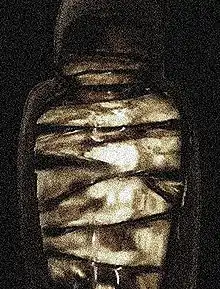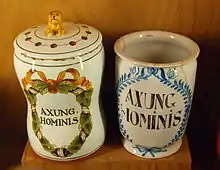Mellified man
A mellified man, or a human mummy confection, was a legendary medicinal substance created by steeping a human cadaver in honey. The concoction is detailed in Chinese medical sources, including the Bencao Gangmu of the 16th century. Relying on a second-hand account, the text reports a story that some elderly men in Arabia, nearing the end of their lives, would submit themselves to a process of mummification in honey to create a healing confection.[1]

This process differed from a simple body donation because of the aspect of self-sacrifice; the mellification process would ideally start before death. The donor would stop eating any food other than honey, going as far as to bathe in the substance. Shortly, the donor's feces and even sweat would consist of honey. When this diet finally proved fatal, the donor's body would be placed in a stone coffin filled with honey.[2]
After a century or so, the contents would have turned into a sort of confection reputedly capable of healing broken limbs and other ailments. This confection would then be sold in street markets as a hard to find item with a hefty price.
Origins
| Wikisource has original text related to this article: |
Some of the earliest known records of mellified corpses come from Greek historian Herodotus (4th century BCE) who recorded that the Assyrians used to embalm their dead with honey.[3] A century later, Alexander the Great's body was reportedly preserved in a honey-filled sarcophagus, and there are also indications that this practice was not unknown to the Egyptians.[4][5]
Another record of mellification is found in the Bencao Gangmu (section 52, "Man as medicine") under the entry for munaiyi (木乃伊 "mummy"). It quotes the Chuogeng lu (輟耕錄 "Talks while the Plough is Resting", c. 1366) by the Yuan dynasty scholar Tao Zongyi (陶宗儀) and Tao Jiucheng (陶九成).
According to [Tao Jiucheng] in his [Chuogenglu], in the lands of the Arabs there are men 70 or 80 years old who are willing to give their bodies to save others. Such a one takes no more food or drink, only bathing and eating a little honey, till after a month his excreta are nothing but honey; then death ensues. His compatriots place the body to macerate in a stone coffin full of honey, with an inscription giving the year and month of burial. After a hundred years the seals are removed and the confection so formed used for the treatment of wounds and fractures of the body and limbs—only a small amount taken internally is needed for the cure. Although it is scarce in those parts the common people call it "mellified man" [miren 蜜人], or, in their foreign speech, "mu-nai-i". Thus Mr. [Tao], but I myself do not know whether the tale is true or not. In any case I append it for the consideration of the learned. [6]
According to Joseph Needham and Lu Gwei-djen, this content was Arabic, but Li Shizhen messed up the story with a Burmese custom of preserving the bodies of abbots and high monks in honey, so that "the Western notion of a drug made from perdurable human flesh was combined with the characteristic Buddhist motif of self-sacrifice for others".[7] In her book Stiff: The Curious Lives of Human Cadavers, writer Mary Roach observes that the text points out that it does not know the veracity of the mellified man story.[1]
Etymology
Bencao Gangmu calls the concoction miren (蜜人), translated as "honey person" or "mellified man". Miziren (蜜漬人 "honey-saturated person") is a modern synonym. The place it comes from is tianfangguo, an old name for Arabia or the Middle East"). The Chinese munaiyi (木乃伊), along with "mummy" loanwords in many other languages, derives from Arabic mūmīya (mummy) or from Persian mūmiyâyī (مومیایی, "mummy"), itself from mūm "wax".
Mellification is a mostly obsolete term for the production of honey, or the process of honeying something, from the Latin mellificāre (“to make honey”), or mel (“honey”). The Ancient Greek word mélissa (μέλισσα) means "bee; honeybee; (poetic) honey".
Physical properties of honey
Honey has been used in funerary practices in many different cultures. Burmese priests have the custom of preserving their chief abbots in coffins full of honey.[8] Its reputation both for medicinal uses and durability is long-established. For at least 2,700 years, honey has been used by humans to treat a variety of ailments through topical application, but only recently have the antiseptic and antibacterial properties of honey been chemically explained. Because of its unique composition and the complex processing of nectar by the bees which changes its chemical properties, honey is suitable for long-term storage and is easily assimilated even after long preservation. History knows examples of honey preservation for decades, centuries and even millennia.[9]
Antibacterial properties of honey are the result of the low water activity causing osmosis, hydrogen peroxide effect,[10] and high acidity.[11] The combination of high acidity, hygroscopic, and antibacterial effects have led to honey's reputation as a plausible way to mummify a human cadaver, despite lack of concrete evidence.
Comparative studies
Both European and Chinese pharmacopeias employed medicines of human origin such as urine therapy, or even other medicinal uses for breast milk. In her book, Roach says the medicinal use of mummies, and the sale of fake ones, is "well documented" in chemistry books of 16th to 18th centuries in Europe, "but nowhere outside Arabia were the corpses volunteers".[12][13][14][15]
Mummies were a common ingredient in the Middle Ages until at least the eighteenth century, and not only as medicine but as fertilizers and even as paint. The use of corpses and body parts as medicine goes far back—in the Roman Empire the blood of dead Gladiators was used as treatment for epilepsy.[16]
In his book, Bernard Read suggests a connection between the European medieval practices and those of the Middle East and China:
The underlying theories which sustained the use of human remedies, find a great deal in common between the Arabs as represented by Avicenna, and China through the [Bencao]. Body humors, vital air, the circulations, and numerous things are more clearly understood if an extended study is made of Avicenna or the Europeans who based their writings on Arabic medicine. The various uses given in many cases common throughout the civilized world, [Nicholas] Lemery also recommended woman's milk for inflamed eyes, feces were applied to sores, and the human skull, brain, blood, nails and "all the parts of man", were used in sixteenth-century Europe.[17]
In popular culture
- The novel The Dervish House by Ian McDonald features a hunt for a mellified man.
- A segment of the eighth episode of the fourth series of the British children's historical sketch show Horrible Histories features this concept.
- The song "Sweet Bod" by Neil Cicierega (also known as Lemon Demon) on the 2016 album Spirit Phone is about this concept, containing many lyrics revolving around a corpse being mummified in honey, and the sale of said honey for medicinal purposes.
References
- Roach, Mary (2008). Stiff: The Curious Lives of Human Cadavers. Paw Prints. ISBN 978-1-4352-8742-6. Retrieved 9 October 2010.
- Salopek, Paul. "In Ancient Burial, Embalming With Honey | Out Of Eden Walk". outofedenwalk.nationalgeographic.com. Archived from the original on 2015-07-23. Retrieved 2015-05-17.
- "Honey I'm dead". National Geographic. Retrieved 2017-09-15.
- Crane, Ethel Eva (2013). The World History of Beekeeping and Honey Hunting. Routledge. pp. 509–510. ISBN 978-1136746697.
- "8 Surprising Facts about Alexander the Great". History.com. Retrieved 2017-09-15.
- Needham, Joseph and Lu Gwei-djen (1974), Science and Civilization in China. Vol. 5., Part 2. Chemistry and Chemical Technology. Part II. Spagyric Discovery and Invention: Magisteries of Gold and Immortality, Cambridge University Press, p. 76.
- Needham and Lu 1974: 76.
- "Bagan".
- The Science Behind Honey's Eternal Shelf Life, Smithsonian Magazine, August 22, 2013, retrieved August 30, 2013
- Wahdan H (1998). "Causes of the antimicrobial activity of honey". Infection. 26 (1): 26–31. doi:10.1007/BF02768748. PMID 9505176.
- Honey as an Antimicrobial Agent, Waikato Honey Research Unit, November 16, 2006, retrieved June 2, 2007
- Le Fèvre, Nicolas (1664). A Compleat Body of Chymistry, tr. Traicté de la chymie. Readex Microprint.
- Pomet, Pierre (1737). A Compleat History of Druggs. London.
- Wootton, A. C. (1910). Chronicles of Pharmacy. Macmillan.
- Thompson, C. J. S. (1929). The Mystery and Art of the Apothecary. Lippincott.
- Bethge, Philip (30 January 2009). "Europe's 'Medicinal Cannibalism': The Healing Power of Death". Spiegel Online. Retrieved 25 October 2012.
- Read, Bernard Emms (1932). Chinese Materia Medica: Animal Drugs. Peking Natural History Bulletin. Retrieved 9 October 2010.
